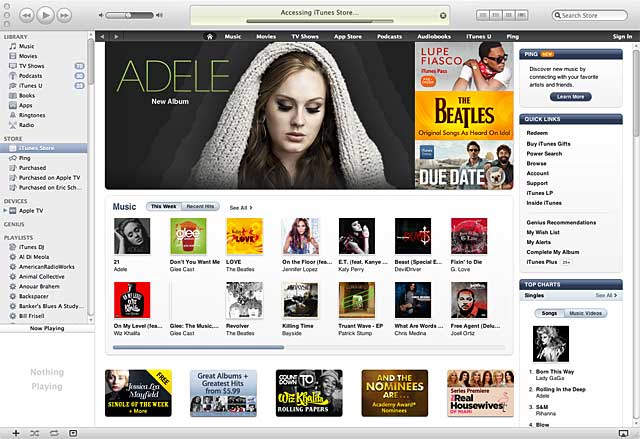2011 Will Be the Year of Streaming Music
"Dynamic spatial and energy offsets within the content affect the coding efficiency of modern lossy codecs," Reams explains. "Any time the content is mixed [in such a way as to create these conflicts], the sound may be rendered needlessly flawed. Linear formats [i.e., magnetic media] are forgiving in regards to sloppy spatial mapping, perceptually irrelevant spectra, and noise. Lossy coding is not."
The offsets Reams refers to are created as part of the music mix, which is implicitly unbalanced by nature. Differences of as little as 1 dB between the same information in each stereo channel can cause the codec to view it as an error rather than a work of art. Ideally, the effect of a codec should be addressed at the point the music is mixed (and MP3 developer Fraunhofer-Gesellschaft debuted something exactly like that at the NAMM Show in Las Vegas in January, which we'll get to in a minute). But, Reams acknowledges, with the biggest news of last year being the arrival of The Beatles on iTunes, the vast majority of music that will be streamed will be legacy content, anything from a year old to 5 decades old.
"If the mastering [deck's] dead azimuth was not perfectly aligned, the audio on the left channel may not be perfectly synchronized with the audio on the right, a little before or a little after. An offset of even one sample can generate enough energy to induce a problem with the [codec] processing," he explains.

Will 2011 be the year that iTunes finally starts offering a streaming music service?
Clean Tracks
Tim Carroll, founder and president of Linear Acoustic, Inc., which makes processing equipment used in streaming and file delivery, emphasizes that starting with a clean track is crucial to music surviving the streaming process with as much integrity as possible. "Most codecs are pretty benign these days-AAC at 224Kbps compared to what we've been used to is pretty spectacular, and the HE-AAC data rate can be lower but still maintain the same quality," he says.
However, the data rates needed to stream fully lossless music files are high and are not going to be the norm in the streaming environment anytime soon, especially to mobile users. Thus, Carroll stresses, the music-mastering stage of the record-making process will be critical, and it will have to work even harder to avoid migrating the problems caused by the ongoing "loudness war" to the streaming environment. The phrase refers to an unspoken, but very real, competition on the part of music content distributors (i.e., record labels) to digitally master and release recordings with higher real, and perceived, levels of loudness. Labels and artists are looking for records that stick out aurally, simply by being louder, whether on the radio or in a club. The practice goes back decades, to the days when Motown Records founder Berry Gordy Jr. would have his staff engineers analyze the top 10 records every week, including how relatively loud they were, so he could have a benchmark for the loudness of Motown' singles. The result is a loud record, perceptually speaking, but it is often sonic mush, artistically speaking, with the dynamic range of each individual instrument blunted and subsumed by the force of the track's overall level.
"When you master a [track] to the point of clipping, every transient, like the kick drum, becomes a square wave, and the processing engine is going to have the hardest time trying to code that, because [clipping] creates harmonics that distract the codec," Carroll explains. "That's just bitrate wasting, because the codec is having to work harder. Codecs choke on clipping artifacts. In a low bitrate environment like streaming, the name of the game is cleanliness from the beginning, free of clipping and square waves and overloads; stuff you can't recover from."
Reams agrees that too much heat in the mix can overwhelm the codec's processing ability. "When people are trying to get that big FM radio sound on their tracks, they're applying something line an Orban or dbx [audio] compressor, but applying too much [audio] compression"-"brickwalling" the mix, in the jargon, using very fast attack and release parameter settings-"and what you get instead is overmodulation as a result of overall aggressive energy compression. It's nice and loud, but it creates sideband points in the spectrum-you put in one tone but you get three or more points on the spectrum that the codec needs to encode. The more frequencies it has to process, the more noise gets added, or it starts overquantizing. That reduces the individual presence of each instrument."
Goran Tomas is a broadcast and streaming specialist working in Zagreb, Croatia. He says that while there is an array of potential codecs that streaming music can use, the consensus has focused on AAC for high-bitrate streaming and AACplus for lower-bitrate environments. AAC supports inclusion of 48 full-bandwidth audio channels of up to 96 kHz in one stream plus 16 low frequency effects (LFE, limited to 120Hz) channels, up to 16 "coupling" or dialog channels, and up to 16 data streams. Its effectiveness increases as the variable bitrate goes up. AACplus, aka HE-AAC (high-efficiency AAC) is optimized for streaming rates down to below 64Kbps and is often used for digital and internet radio streaming.
Related Articles
Listeners get access to more songs and discover new acts, leading to less illegal downloading.
19 Aug 2010
Integrating Lala's streaming service could take iTunes to a whole new level.
30 Apr 2010
Apple's purchase of Lala suggests that iTunes might begin to offer a streaming listening service, while Vevo hopes to become a Hulu for music videos.
Mon., Dec. 7, by Tim Siglin
07 Dec 2009
Companies and Suppliers Mentioned